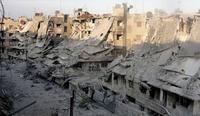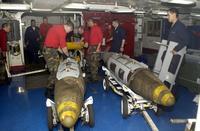-
U.S., Japan reject China’s unilateral East China Sea claims
The Chinese government this past weekend has declared the country’s Air Defense Identification Zone (ADIZ), effective immediately. The zone covers an area in the East China Sea — two-thirds the size of the United Kingdom – which includes islands claimed by both China and Japan. China calls them the Diaoyou islands, while Japan calls them the Senkaku islands. The United States and Japan said they would not abide by China’s unilateral decision, and on Tuesday the United States sent two B-52s long-range bombers to conduct “routine training mission” through the airspace China declared as its own, and did so without following China’s instructions about how aircraft should conduct themselves in that space.
-
-
Navy “mine-hunter” AUV sets mission-endurance record
The U.S. Naval Research Laboratory’s (NRL) Acoustics Division, with Bluefin Robotics, executed a record setting 507 kilometer (315 mile), long-endurance autonomy research mission using its heavyweight-class mine countermeasures autonomous underwater vehicle (AUV), Reliant. NRL’s Reliant AUV, when equipped with a low frequency broadband (LFBB) sonar system, is perhaps best known as the prototype for the new U.S. Navy Knifefish mine-hunter.
-
-
Uranium, plutonium, heavy water … why Iran’s nuclear deal matters
The agreement reached with Iran will limit enrichment to 5 percent U-235 and allow International Atomic Energy Agency (IAEA) inspectors regular visits (even daily) to their facilities. The inspectors can easily determine the ratios of U-235 and Pu-239 in the input fuel and waste streams via the characteristic radiation signatures of the isotopes involved. These stand out like a sore thumb to their instruments. In addition, the IAEA will measure the amount of U-235 employed at each facility to determine if any of the uranium is diverted to undisclosed locations. While this arrangement is operating it is highly unlikely that Iran will be able to build nuclear weapons.
-
-
The interim agreement between the P5+1 and Iran: the details
The P5+1 countries (the United States, United Kingdom, Germany, France, Russia, and China, facilitated by the European Union) have been engaged in negotiations with Iran in an effort to reach a verifiable diplomatic resolution which would prevent Iran from obtaining a nuclear weapon. On Sunday, the P5+1 and Iran reached a set of initial understandings which halts, at least temporarily, the progress of Iran’s nuclear program and rolls it back in key respects. In return, for Iran’s concessions, and as part of this initial step, the P5+1 will provide what the agreement describes as “limited, temporary, targeted, and reversible” relief to Iran.
-
-
Off-shore barges considered for destroying Syria’s chemical weapons
After failing to find a country willing to allow its territory to be used for disposing of Syria’s chemical weapons, the United States is exploring other options. Two options being seriously considered involve the destruction of Syria’s chemical weapons off shore, rather than on land. Both proposals call for removing the chemical weapons from Syria and placing them on a large barge at sea, where they would be dissolved or incinerated.
-
-
Sahel-Sahara countries to build joint security training center in Rabat
At a meeting on common security challenges in north and west Africa, government officials from nineteen Sahel, Sahara, and Maghreb countries agreed to build a joint security training center in Rabat, Morocco, to increase the competency of the region’s security forces to deal with growing terrorist and jihadist threats. The nineteen countries will also increase information sharing and harmonize the legal means they use to fight security threats. The ministers said that one of the first steps toward improving security in west and north Africa would be to improve monitoring of border and increase border security.
-
-
U.S. to intensify campaign against brutal Lord’s Resistance Army (LRA)

U.S. Special Forces continue to act on their commitment to capture Joseph Kony, leader of the Lord’s Resistance Army(LRA), a band of brutal rebels who have been kidnapping and killing villagers across central Africa for some years now. For the last two years, American military advisers have been assisting troops in four African nations — Uganda, South Sudan, Congo, and Central African Republic – in their war against the elusive LRA. Recently, the Pentagon has asked the White House for permission to expand the mission by using the Air Force’s CV-22 Osprey aircraft in Uganda, allowing troops to advance the assault on Kony.
-
-
Destroying Syria's chemical weapons in the midst of war
Close to 1,400 tons of chemical weapons are stored at twenty-three locations scattered throughout Syria. To destroy this stockpile, officials will need multiple strategies. The most dangerous are the munitions filled with “live” chemical agents, such as mustard gas, sarin, and VX. Dealing with these weapons will require bringing specialized equipment into the war-torn country.
-
-
Marines test latest battlefield IT at Agile Bloodhound ‘13
Marines in Hawaii last week demonstrated that using handheld devices and special software automatically to sift through loads of data can help ease information overload and deliver made-to-order intelligence to the front lines. “We’re trying to create a user-oriented world view for Marines,” said Col. William Zamagni. “Whether they’re in command centers with PCs, in vehicles with laptops or on foot with smartphones, Marines need access to the most pertinent information possible.”
-
-
France to offer counter-terrorism support to Libya
French Foreign Minister Laurent Fabius has confirmed that France is considering providing Libya additional aid in counter-terrorism and police training. Since the NATO-supported revolt removed Muammar Gaddafi from office two years ago, Libya has not had an effective central government, and the country has turned into a battleground for rival militias and al Qaeda-linked militants.
-
-
Security agencies concerned about plastic guns
The Undetectable firearms Act of 1988, which makes it illegal to manufacture, import, sell, ship, deliver, process, transfer, or receive a firearm which is not detectable by walk-through metal detection, is set to expire on 9 December 2013. If Congress fails to reauthorize the law, plastic guns will no longer require metal components which are detectable by metal detectors. “When these 3D firearms are manufactured, some of the weapons can defeat normal detection such as metal detectors, wands, and it could present a problem to public safety in a venue such as an airport, an arena, a courthouse,” says ATF assistant director Richard Marianos.
-
-
Sticks over carrots: the rationale of Assad’s counterinsurgency “madness”

Counterinsurgency (COIN) efforts by the West, particularly over the past decade, have emphasized the limitation of violence and the importance of the local population. Western COIN practice focuses on establishing the perception of state legitimacy in the area around which the insurgency is taking place. The objective is to sway influence away from the insurgents and towards the regime by providing security, services, stability and growth. By contrast, Syrian efforts in counterinsurgency have not only avoided securing the civilian population, but have actively targeted it. Whereas Western COIN prioritizes “the people,” the Syrian strategy focuses on the elimination of the militant opposition regardless of the collateral violence. Assad’s “enemy-centric” approaches to counterinsurgency utilizes intense violence — targeting of refugees, schools, hospitals, and using chemical weapons — to divide public support from the insurgency by punishing the civil population.
-
-
The Ergonomics of bomb-making at sea

In an effort to stem work-related injuries and speed the assembly of munitions aboard aircraft carriers, the Office of Naval Research (ONR) spearheaded the development of a more efficient and ergonomic way to build bombs at sea. The ONR-sponsored improvements will allow sailors to move around more freely and assemble multiple bombs simultaneously on smaller, individual stands.
-
-
Emulating stingray movement to build next generation of submarines
Stingrays swim through water with such ease that researchers believe that emulating the fish’s unique way of swimming could improve deep-sea vehicles’ agility and fuel efficiency. “Most fish wag their tails to swim. A stingray’s swimming is much more unique, like a flag in the wind,” says one researcher.
-
-
Insects’ way of flying inspires design of tiny flying robots
Researchers have identified some of the underlying physics that may explain how insects can so quickly recover from a stall in midflight — unlike conventional fixed wing aircraft, where a stalled state often leads to a crash landing. The analysis improves the understanding of how insects fly and informs the design of small flying robots built for intelligence gathering, surveillance, search-and-rescue, and other purposes.
-
More headlines
The long view
Factories First: Winning the Drone War Before It Starts
Wars are won by factories before they are won on the battlefield,Martin C. Feldmann writes, noting that the United States lacks the manufacturing depth for the coming drone age. Rectifying this situation “will take far more than procurement tweaks,” Feldmann writes. “It demands a national-level, wartime-scale industrial mobilization.”
